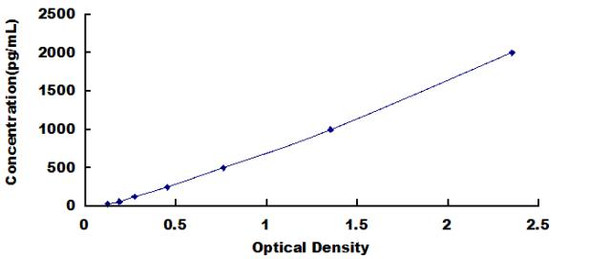Human Cell Biology ELISA Kits 1
Human ITGB3 (Integrin Beta 3) ELISA Kit (HUES03098)
- SKU:
- HUES03098
- Product Type:
- ELISA Kit
- Size:
- 96 Assays
- Uniprot:
- P05106
- Sensitivity:
- 0.09ng/mL
- Range:
- 0.16-10ng/mL
- ELISA Type:
- Sandwich
- Synonyms:
- BDPLT2, CD61, GP3A, GPIIIa, GT, ITG-B3, Platelet Membrane Glycoprotein IIIa
- Reactivity:
- Human
- Sample Type:
- Serum, plasma and other biological fluids
- Research Area:
- Cell Biology
Description
| Assay type: | Sandwich |
| Format: | 96T |
| Assay time: | 4.5h |
| Reactivity: | Human |
| Detection Method: | Colormetric |
| Detection Range: | 0.16-10 ng/mL |
| Sensitivity: | 0.10 ng/mL |
| Sample Volume Required Per Well: | 100µL |
| Sample Type: | Serum, plasma and other biological fluids |
| Specificity: | This kit recognizes Human ITGB3 in samples. No significant cross-reactivity or interference between Human ITGB3 and analogues was observed. |
This ELISA kit uses Sandwich-ELISA as the method. The micro ELISA plate provided in this kit has been pre-coated with an antibody specific to Human ITGB3. Standards or samples are added to the appropriate micro ELISA plate wells and combined with the specific antibody. Then a biotinylated detection antibody specific for Human ITGB3 and Avidin-Horseradish Peroxidase (HRP) conjugate are added to each micro plate well successively and incubated. Free components are washed away. The substrate solution is added to each well. Only those wells that contain Human ITGB3, biotinylated detection antibody and Avidin-HRP conjugate will appear blue in color. The enzyme-substrate reaction is terminated by adding Stop Solution and the color turns yellow. The optical density (OD) is measured spectrophotometrically at a wavelength of 450 nm ± 2 nm. The OD value is proportional to the concentration of Human ITGB3. The concentration of Human ITGB3 in samples can be calculated by comparing the OD of the samples to the standard curve.
| UniProt Protein Function: | ITGB3: integrin alpha-V/beta-3 is a receptor for cytotactin, fibronectin, laminin, matrix metalloproteinase-2, osteopontin, osteomodulin, prothrombin, thrombospondin, vitronectin and von Willebrand factor. Integrin alpha-IIB/beta-3 is a receptor for fibronectin, fibrinogen, plasminogen, prothrombin, thrombospondin and vitronectin. Integrins alpha-IIB/beta-3 and alpha-V/beta-3 recognize the sequence R-G-D in a wide array of ligands. Integrin alpha-IIB/beta-3 recognizes the sequence H-H-L-G-G-G-A-K-Q-A-G-D-V in fibrinogen gamma chain. Following activation integrin alpha- IIB/beta-3 brings about platelet/platelet interaction through binding of soluble fibrinogen. This step leads to rapid platelet aggregation which physically plugs ruptured endothelial surface. |
| UniProt Protein Details: | Protein type:Membrane protein, integral; Motility/polarity/chemotaxis; Cell adhesion Chromosomal Location of Human Ortholog: 17q21. 32 Cellular Component: cell surface; filopodium membrane; focal adhesion; integral to plasma membrane; integrin complex; melanosome; microvillus membrane; nucleus; plasma membrane; platelet alpha granule membrane; receptor complex Molecular Function:C-X3-C chemokine binding; cell adhesion molecule binding; coreceptor activity; enzyme binding; extracellular matrix binding; fibroblast growth factor binding; fibronectin binding; identical protein binding; insulin-like growth factor I binding; platelet-derived growth factor receptor binding; protease binding; protein binding; protein disulfide isomerase activity; vascular endothelial growth factor receptor 2 binding Biological Process: activation of protein kinase activity; angiogenesis involved in wound healing; blood coagulation; cell adhesion; cell growth; cell migration; cell-matrix adhesion; cell-substrate adhesion; entry of virus into host cell; extracellular matrix organization and biogenesis; heterotypic cell-cell adhesion; integrin-mediated signaling pathway; leukocyte migration; mesodermal cell differentiation; negative chemotaxis; negative regulation of lipid transport; negative regulation of lipoprotein metabolic process; negative regulation of low-density lipoprotein receptor biosynthetic process; platelet activation; platelet degranulation; positive regulation of endothelial cell proliferation; positive regulation of peptidyl-tyrosine phosphorylation; positive regulation of protein amino acid phosphorylation; positive regulation of vascular endothelial growth factor receptor signaling pathway; regulation of bone resorption; smooth muscle cell migration; tube development; vascular endothelial growth factor receptor signaling pathway; wound healing Disease: Bleeding Disorder, Platelet-type, 16; Glanzmann Thrombasthenia; Myocardial Infarction, Susceptibility To |
| NCBI Summary: | The ITGB3 protein product is the integrin beta chain beta 3. Integrins are integral cell-surface proteins composed of an alpha chain and a beta chain. A given chain may combine with multiple partners resulting in different integrins. Integrin beta 3 is found along with the alpha IIb chain in platelets. Integrins are known to participate in cell adhesion as well as cell-surface mediated signalling. [provided by RefSeq, Jul 2008] |
| UniProt Code: | P05106 |
| NCBI GenInfo Identifier: | 125987835 |
| NCBI Gene ID: | 3690 |
| NCBI Accession: | P05106. 2 |
| UniProt Secondary Accession: | P05106,O15495, Q12806, Q13413, Q14648, Q16499, A0PJW2 D3DXJ8, |
| UniProt Related Accession: | P05106 |
| Molecular Weight: | 86,694 Da |
| NCBI Full Name: | Integrin beta-3 |
| NCBI Synonym Full Names: | integrin subunit beta 3 |
| NCBI Official Symbol: | ITGB3 |
| NCBI Official Synonym Symbols: | GT; CD61; GP3A; BDPLT2; GPIIIa; BDPLT16 |
| NCBI Protein Information: | integrin beta-3 |
| UniProt Protein Name: | Integrin beta-3 |
| UniProt Synonym Protein Names: | Platelet membrane glycoprotein IIIa; GPIIIa; CD_antigen: CD61 |
| Protein Family: | Integrin |
| UniProt Gene Name: | ITGB3 |
| UniProt Entry Name: | ITB3_HUMAN |
As the OD values of the standard curve may vary according to the conditions of the actual assay performance (e. g. operator, pipetting technique, washing technique or temperature effects), the operator should establish a standard curve for each test. Typical standard curve and data is provided below for reference only.
| Concentration (ng/mL) | O.D | Average | Corrected |
| 10 | 2.225 2.261 | 2.243 | 2.164 |
| 5 | 1.525 1.539 | 1.532 | 1.453 |
| 2.5 | 0.82 0.818 | 0.819 | 0.74 |
| 1.25 | 0.396 0.398 | 0.397 | 0.318 |
| 0.63 | 0.268 0.24 | 0.254 | 0.175 |
| 0.32 | 0.174 0.172 | 0.173 | 0.094 |
| 0.16 | 0.124 0.132 | 0.128 | 0.049 |
| 0 | 0.075 0.083 | 0.079 | -- |
Precision
Intra-assay Precision (Precision within an assay): 3 samples with low, mid range and high level Human ITGB3 were tested 20 times on one plate, respectively.
Inter-assay Precision (Precision between assays): 3 samples with low, mid range and high level Human ITGB3 were tested on 3 different plates, 20 replicates in each plate.
| Intra-assay Precision | Inter-assay Precision | |||||
| Sample | 1 | 2 | 3 | 1 | 2 | 3 |
| n | 20 | 20 | 20 | 20 | 20 | 20 |
| Mean (ng/mL) | 0.54 | 1.48 | 3.46 | 0.54 | 1.56 | 3.66 |
| Standard deviation | 0.03 | 0.09 | 0.19 | 0.03 | 0.08 | 0.13 |
| C V (%) | 5.56 | 6.08 | 5.49 | 5.56 | 5.13 | 3.55 |
Recovery
The recovery of Human ITGB3 spiked at three different levels in samples throughout the range of the assay was evaluated in various matrices.
| Sample Type | Range (%) | Average Recovery (%) |
| Serum (n=5) | 85-96 | 91 |
| EDTA plasma (n=5) | 87-100 | 93 |
| Cell culture media (n=5) | 91-107 | 98 |
Linearity
Samples were spiked with high concentrations of Human ITGB3 and diluted with Reference Standard & Sample Diluent to produce samples with values within the range of the assay.
| Serum (n=5) | EDTA plasma (n=5) | Cell culture media (n=5) | ||
| 1:2 | Range (%) | 93-105 | 89-104 | 95-109 |
| Average (%) | 100 | 95 | 102 | |
| 1:4 | Range (%) | 85-99 | 80-90 | 83-98 |
| Average (%) | 92 | 85 | 90 | |
| 1:8 | Range (%) | 86-98 | 80-90 | 86-99 |
| Average (%) | 93 | 86 | 92 | |
| 1:16 | Range (%) | 87-102 | 86-100 | 88-100 |
| Average (%) | 93 | 93 | 93 |
An unopened kit can be stored at 4°C for 1 month. If the kit is not used within 1 month, store the items separately according to the following conditions once the kit is received.
| Item | Specifications | Storage |
| Micro ELISA Plate(Dismountable) | 8 wells ×12 strips | -20°C, 6 months |
| Reference Standard | 2 vials | |
| Concentrated Biotinylated Detection Ab (100×) | 1 vial, 120 µL | |
| Concentrated HRP Conjugate (100×) | 1 vial, 120 µL | -20°C(shading light), 6 months |
| Reference Standard & Sample Diluent | 1 vial, 20 mL | 4°C, 6 months |
| Biotinylated Detection Ab Diluent | 1 vial, 14 mL | |
| HRP Conjugate Diluent | 1 vial, 14 mL | |
| Concentrated Wash Buffer (25×) | 1 vial, 30 mL | |
| Substrate Reagent | 1 vial, 10 mL | 4°C(shading light) |
| Stop Solution | 1 vial, 10 mL | 4°C |
| Plate Sealer | 5 pieces | |
| Product Description | 1 copy | |
| Certificate of Analysis | 1 copy |
- Set standard, test sample and control (zero) wells on the pre-coated plate and record theirpositions. It is recommended to measure each standard and sample in duplicate. Note: addall solutions to the bottom of the plate wells while avoiding contact with the well walls. Ensuresolutions do not foam when adding to the wells.
- Aliquot 100µl of standard solutions into the standard wells.
- Add 100µl of Sample / Standard dilution buffer into the control (zero) well.
- Add 100µl of properly diluted sample (serum, plasma, tissue homogenates and otherbiological fluids) into test sample wells.
- Cover the plate with the sealer provided in the kit and incubate for 90 min at 37°C.
- Aspirate the liquid from each well, do not wash. Immediately add 100µL of BiotinylatedDetection Ab working solution to each well. Cover the plate with a plate seal and gently mix. Incubate for 1 hour at 37°C.
- Aspirate or decant the solution from the plate and add 350µL of wash buffer to each welland incubate for 1-2 minutes at room temperature. Aspirate the solution from each well andclap the plate on absorbent filter paper to dry. Repeat this process 3 times. Note: a microplatewasher can be used in this step and other wash steps.
- Add 100µL of HRP Conjugate working solution to each well. Cover with a plate seal andincubate for 30 min at 37°C.
- Aspirate or decant the solution from each well. Repeat the wash process for five times asconducted in step 7.
- Add 90µL of Substrate Reagent to each well. Cover with a new plate seal and incubate forapproximately 15 min at 37°C. Protect the plate from light. Note: the reaction time can beshortened or extended according to the actual color change, but not by more than 30min.
- Add 50 µL of Stop Solution to each well. Note: Adding the stop solution should be done inthe same order as the substrate solution.
- Determine the optical density (OD value) of each well immediately with a microplate readerset at 450 nm.






